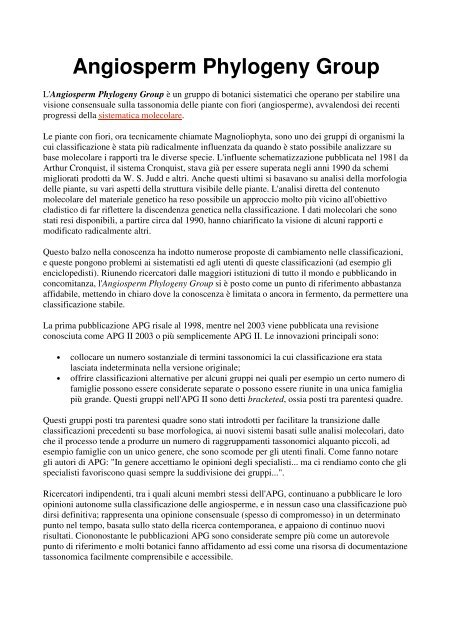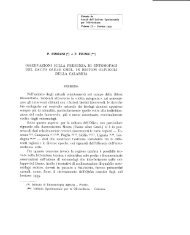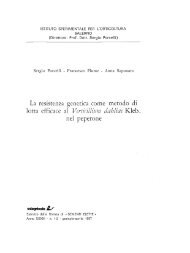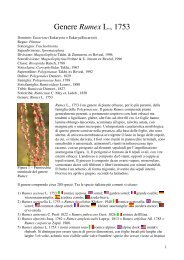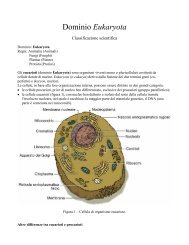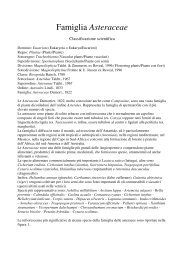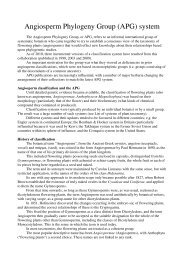Angiosperm Phylogeny Group
Angiosperm Phylogeny Group
Angiosperm Phylogeny Group
Create successful ePaper yourself
Turn your PDF publications into a flip-book with our unique Google optimized e-Paper software.
<strong>Angiosperm</strong> <strong>Phylogeny</strong> <strong>Group</strong><br />
L'<strong>Angiosperm</strong> <strong>Phylogeny</strong> <strong>Group</strong> è un gruppo di botanici sistematici che operano per stabilire una<br />
visione consensuale sulla tassonomia delle piante con fiori (angiosperme), avvalendosi dei recenti<br />
progressi della sistematica molecolare.<br />
Le piante con fiori, ora tecnicamente chiamate Magnoliophyta, sono uno dei gruppi di organismi la<br />
cui classificazione è stata più radicalmente influenzata da quando è stato possibile analizzare su<br />
base molecolare i rapporti tra le diverse specie. L'influente schematizzazione pubblicata nel 1981 da<br />
Arthur Cronquist, il sistema Cronquist, stava già per essere superata negli anni 1990 da schemi<br />
migliorati prodotti da W. S. Judd e altri. Anche questi ultimi si basavano su analisi della morfologia<br />
delle piante, su vari aspetti della struttura visibile delle piante. L'analisi diretta del contenuto<br />
molecolare del materiale genetico ha reso possibile un approccio molto più vicino all'obiettivo<br />
cladistico di far riflettere la discendenza genetica nella classificazione. I dati molecolari che sono<br />
stati resi disponibili, a partire circa dal 1990, hanno chiarificato la visione di alcuni rapporti e<br />
modificato radicalmente altri.<br />
Questo balzo nella conoscenza ha indotto numerose proposte di cambiamento nelle classificazioni,<br />
e queste pongono problemi ai sistematisti ed agli utenti di queste classificazioni (ad esempio gli<br />
enciclopedisti). Riunendo ricercatori dalle maggiori istituzioni di tutto il mondo e pubblicando in<br />
concomitanza, l'<strong>Angiosperm</strong> <strong>Phylogeny</strong> <strong>Group</strong> si è posto come un punto di riferimento abbastanza<br />
affidabile, mettendo in chiaro dove la conoscenza è limitata o ancora in fermento, da permettere una<br />
classificazione stabile.<br />
La prima pubblicazione APG risale al 1998, mentre nel 2003 viene pubblicata una revisione<br />
conosciuta come APG II 2003 o più semplicemente APG II. Le innovazioni principali sono:<br />
• collocare un numero sostanziale di termini tassonomici la cui classificazione era stata<br />
lasciata indeterminata nella versione originale;<br />
• offrire classificazioni alternative per alcuni gruppi nei quali per esempio un certo numero di<br />
famiglie possono essere considerate separate o possono essere riunite in una unica famiglia<br />
più grande. Questi gruppi nell'APG II sono detti bracketed, ossia posti tra parentesi quadre.<br />
Questi gruppi posti tra parentesi quadre sono stati introdotti per facilitare la transizione dalle<br />
classificazioni precedenti su base morfologica, ai nuovi sistemi basati sulle analisi molecolari, dato<br />
che il processo tende a produrre un numero di raggruppamenti tassonomici alquanto piccoli, ad<br />
esempio famiglie con un unico genere, che sono scomode per gli utenti finali. Come fanno notare<br />
gli autori di APG: "In genere accettiamo le opinioni degli specialisti... ma ci rendiamo conto che gli<br />
specialisti favoriscono quasi sempre la suddivisione dei gruppi...".<br />
Ricercatori indipendenti, tra i quali alcuni membri stessi dell'APG, continuano a pubblicare le loro<br />
opinioni autonome sulla classificazione delle angiosperme, e in nessun caso una classificazione può<br />
dirsi definitiva; rappresenta una opinione consensuale (spesso di compromesso) in un determinato<br />
punto nel tempo, basata sullo stato della ricerca contemporanea, e appaiono di continuo nuovi<br />
risultati. Ciononostante le pubblicazioni APG sono considerate sempre più come un autorevole<br />
punto di riferimento e molti botanici fanno affidamento ad essi come una risorsa di documentazione<br />
tassonomica facilmente comprensibile e accessibile.
Classificazione APG II<br />
La classificazione APG II, o sistema APG II, è la classificazione scientifica delle angiosperme<br />
basata sugli aggiornamenti più recenti (2003) dell'<strong>Angiosperm</strong> <strong>Phylogeny</strong> <strong>Group</strong> (vedi).<br />
Legenda dei simboli<br />
• * nuova collocazione della famiglia in APG II (2003)<br />
• + nuovo ordine riconosciuto dal sistema APG II (2003)<br />
• § nuova circoscrizione della famiglia (descritta nel testo delle pubblicazioni APG)<br />
I gruppi tra parentesi quadre sono alternative monofiletiche accettabili ma alle quali viene preferita<br />
(dall'APG) una circoscrizione più allargata (la voce non messa tra parentesi che le precede).<br />
Gruppi radice<br />
La genesi di questi gruppi viene ritenuta parallela a quella del resto delle angiosperme o<br />
degli altri gruppi principali, ragion per cui sono isolati dal resto della classificazione.<br />
Amborellaceae Pichon (1948), nom. cons.<br />
Chloranthaceae R.Br. ex. Sims (1820), nom. cons.<br />
Nymphaeaceae Salisb. (1805), nom. cons.<br />
[ Cabombaceae Rich. ex. A.Rich. (1822), nom. cons. ]<br />
+ Austrobaileyales Takht. ex. Reveal (1992)<br />
Austrobaileyaceae (Croizat) Croizat (1943), nom. cons.<br />
§ Schisandraceae Blume (1830), nom. cons.<br />
[ Illiciaceae A.C.Sm. (1947), nom. cons. ]<br />
Trimeniaceae L.S.Gibbs (1917), nom. cons.<br />
Ceratophyllales Bisch. (1839)<br />
Ceratophyllaceae Gray (1821), nom. cons.<br />
Magnoliidi<br />
+ Canellales Cronquist<br />
Canellaceae Mart. (1832), nom. cons.<br />
Winteraceae R.Br. ex Lindl. (1830), nom. cons.<br />
Laurales Perleb (1826)<br />
Atherospermataceae R.Br. (1814)<br />
Calycanthaceae Lindl. (1819), nom. cons.<br />
Gomortegaceae Reiche (1896), nom. cons.<br />
Hernandiaceae Bercht. & J.Presl (1820), nom. cons.<br />
Lauraceae Juss. (1789), nom. cons.<br />
Monimiaceae Juss. (1809), nom. cons.<br />
Siparunaceae (A.DC.) Schodde 1970
Magnoliales Bromhead (1838)<br />
Annonaceae Juss. (1789), nom. cons.<br />
Degeneriaceae I.W.Bailey & A.C.Sm. (1942), nom. cons.<br />
Eupomatiaceae Endl. (1841), nom. cons.<br />
Himantandraceae Diels (1917), nom. cons.<br />
Magnoliaceae Juss. (1789), nom. cons.<br />
Myristicaceae R.Br. (1810), nom. cons.<br />
Piperales Dumort. (1829)<br />
Aristolochiaceae Juss. (1789), nom. cons.<br />
* Hydnoraceae C.Agardh (1821), nom. cons.<br />
Lactoridaceae Engl. (1888), nom. cons.<br />
Piperaceae Bercht. & J.Presl (1820), nom. cons.<br />
Saururaceae Martynov (1820), nom. cons.<br />
Monocotiledoni<br />
§ Petrosaviaceae Hutch. (1934), nom. cons.<br />
Acorales Reveal (1996)<br />
Acoraceae Martynov (1820)<br />
Alismatales Dumort. (1829)<br />
Alismataceae Vent. (1799), nom. cons.<br />
Aponogetonaceae J.Agardh (1858), nom. cons.<br />
Araceae Juss. (1789), nom. cons.<br />
Butomaceae Mirb. (1804), nom. cons.<br />
Cymodoceaceae N.Taylor (1909), nom. cons.<br />
Hydrocharitaceae Juss. (1789), nom. cons.<br />
Juncaginaceae Rich. (1808), nom. cons.<br />
Limnocharitaceae Takht. ex Cronquist (1981)<br />
Posidoniaceae Hutch. (1934), nom. cons.<br />
Potamogetonaceae Rchb. (1828), nom. cons.<br />
Ruppiaceae Horan. (1834), nom. cons.<br />
Scheuchzeriaceae F.Rudolphi (1830), nom. cons.<br />
Tofieldiaceae Takht. (1995)<br />
Zosteraceae Dumort. (1829), nom. cons.<br />
Asparagales Bromhead (1838)<br />
§ Alliaceae Batsch ex. Borkh. (1797), nom. cons.<br />
[ Agapanthaceae F.Voigt (1850) ]<br />
[ Amaryllidaceae J.St.-Hil. (1805), nom. cons. ]<br />
§ Asparagaceae Juss. (1789), nom. cons.<br />
[ Agavaceae Dumort. (1829), nom. cons. ]<br />
[ Aphyllanthaceae Burnett (1835) ]<br />
[ Hesperocallidaceae Traub (1972) ]<br />
[ Hyacinthaceae Batsch ex. Borkh. (1797) ]<br />
[ Laxmanniaceae Bubani (1901) ]<br />
[ Ruscaceae Spreng. (1826), nom. cons. ]<br />
[ Themidaceae Salisb. (1866) ]<br />
Asteliaceae Dumort. (1829)
Blandfordiaceae R.Dahlgren & Clifford (1985)<br />
Boryaceae (Baker) M.W.Chase, Rudall & Conran (1997)<br />
Doryanthaceae R.Dahlgren & Clifford (1985)<br />
Hypoxidaceae R.Br. (1814), nom. cons.<br />
Iridaceae Juss. (1789), nom. cons.<br />
Ixioliriaceae Nakai (1943)<br />
Lanariaceae H.Huber ex R.Dahlgren & A.E. van Wyk (1988)<br />
Orchidaceae Juss. (1789), nom. cons.<br />
Tecophilaeaceae Leyb. (1862), nom. cons.<br />
§ Xanthorrhoeaceae Dumort. (1829), nom. cons.<br />
[ Asphodelaceae Juss. (1789) ]<br />
[ Hemerocallidaceae R.Br. (1810) ]<br />
Xeronemataceae M.W.Chase, Rudall & M.F.Fay (2001)<br />
Dioscoreales Hook.f. (1873)<br />
§ Burmanniaceae Blume (1827), nom. cons.<br />
§ Dioscoreaceae R.Br. (1810), nom. cons.<br />
Nartheciaceae Fr. ex Bjurzon (1846)<br />
Liliales Perleb (1826)<br />
Alstroemeriaceae Dumort. (1829), nom. cons.<br />
Campynemataceae Dumort. (1829)<br />
Colchicaceae DC. (1804), nom. cons.<br />
* Corsiaceae Becc. (1878), nom. cons.<br />
Liliaceae Juss. (1789), nom. cons.<br />
Luzuriagaceae Lotsy (1911)<br />
Melanthiaceae Batsch ex Borkh. (1796), nom. cons.<br />
Philesiaceae Dumort. (1829), nom. cons.<br />
Rhipogonaceae Conran & Clifford (1985)<br />
Smilacaceae Vent. (1799), nom. cons.<br />
Pandanales Lindl. (1833)<br />
Cyclanthaceae Poit. ex A.Rich. (1824), nom. cons.<br />
Pandanaceae R.Br. (1810), nom. cons.<br />
Stemonaceae Caruel (1878), nom. cons.<br />
* Triuridaceae Gardner (1843), nom. cons.<br />
Velloziaceae Hook. (1827), nom. cons.<br />
Commelinidi<br />
Dasypogonaceae Dumort. (1829)<br />
Arecales Bromhead (1840)<br />
Arecaceae Schultz Sch. (1832), nom. cons.<br />
Commelinales Dumort. (1829)<br />
Commelinaceae Mirb. (1804), nom. cons.<br />
Haemodoraceae R.Br. (1810), nom. cons.<br />
* Hanguanaceae Airy Shaw (1964)<br />
Philydraceae Link (1821), nom. cons.<br />
Pontederiaceae Kunth (1816), nom. cons.
Poales Small (1903)<br />
Anarthriaceae D.F.Cutler & Airy Shaw (1965)<br />
* Bromeliaceae Juss. (1789), nom. cons.<br />
Centrolepidaceae Endl. (1836), nom. cons.<br />
Cyperaceae Juss. (1789), nom. cons.<br />
Ecdeiocoleaceae D.F.Cutler & Airy Shaw (1965)<br />
Eriocaulaceae Martynov (1820), nom. cons.<br />
Flagellariaceae Dumort. (1829), nom. cons.<br />
Hydatellaceae U.Hamann (1976)<br />
Joinvilleaceae Toml. & A.C. Sm. (1970)<br />
Juncaceae Juss. (1789), nom. cons.<br />
* Mayacaceae Kunth (1842), nom. cons.<br />
Poaceae (R.Br.)Barnh.1895, nom. cons.<br />
* Rapateaceae Dumort. (1829), nom. cons.<br />
Restionaceae R.Br. (1810), nom. cons.<br />
Sparganiaceae Hanin (1811), nom. cons.<br />
§ Thurniaceae Engl. (1907), nom. cons.<br />
Typhaceae Juss. (1789), nom. cons.<br />
§ Xyridaceae C.Agardh (1823), nom. cons.<br />
Zingiberales Griseb. (1854)<br />
Cannaceae Juss. (1789), nom. cons.<br />
Costaceae Nakai (1941)<br />
Heliconiaceae Nakai (1941)<br />
Lowiaceae Ridl. (1924), nom. cons.<br />
Marantaceae R.Br. (1814), nom. cons.<br />
Musaceae Juss. (1789), nom. cons.<br />
Strelitziaceae Hutch. (1934), nom. cons.<br />
Zingiberaceae Martynov (1820), nom. cons.<br />
Eudicotiledoni<br />
Alcuni autori utilizzano la classe Rosopsida per questo gruppo.<br />
§ Buxaceae Dumort. (1822), nom. cons.<br />
[ Didymelaceae Leandri (1937) ]<br />
Sabiaceae Blume (1851), nom. cons.<br />
Trochodendraceae Eichler (1865), nom. cons.<br />
[ Tetracentraceae A.C.Sm. (1945), nom. cons. ]<br />
Proteales Dumort. (1829)<br />
Nelumbonaceae Bercht. & J.Presl (1820), nom. cons.<br />
§ Proteaceae Juss. (1789), nom. cons.<br />
[ Platanaceae T.Lestib. (1826), nom. cons. ]<br />
Ranunculales Dumort. (1829)<br />
Berberidaceae Juss. (1789), nom. cons.<br />
Circaeasteraceae Hutch. (1926), nom. cons.<br />
[ Kingdoniaceae A.S.Foster ex Airy Shaw (1964) ]<br />
Eupteleaceae K.Wilh. (1910), nom. cons.<br />
Lardizabalaceae R.Br. (1821), nom. cons.
Menispermaceae Juss. (1789), nom. cons.<br />
Papaveraceae Juss. (1789), nom. cons.<br />
[ Fumariaceae Bercht. & J.Presl (1820), nom. cons. ]<br />
[ Pteridophyllaceae (Murb.)Nakai ex Reveal & Hoogland (1991) ]<br />
Ranunculaceae Juss. (1789), nom. cons.<br />
Core eudicots<br />
Aextoxicaceae Engl. & Gilg (1920), nom. cons.<br />
Berberidopsidaceae Takht. (1985)<br />
Dilleniaceae Salisb. (1807), nom. cons.<br />
+ Gunnerales Takht. ex Reveal (1992)<br />
§ Gunneraceae Meisn. (1842), nom. cons.<br />
[ Myrothamnaceae Nied. (1891), nom. cons. ]<br />
Caryophyllales Perleb (1826)<br />
Achatocarpaceae Heimerl. (1934), nom. cons.<br />
Aizoaceae Martynov (1820), nom. cons.<br />
Amaranthaceae Juss. (1789), nom. cons.<br />
Ancistrocladaceae Planch. ex Walp. (1851), nom. cons.<br />
Asteropeiaceae (Szyszyl.) Takht. ex Reveal & Hoogland (1990)<br />
* Barbeuiaceae Nakai (1942)<br />
Basellaceae Raf. (1837), nom. cons.<br />
Cactaceae Juss. (1789), nom. cons.<br />
Caryophyllaceae Juss. (1789), nom. cons.<br />
Didiereaceae Radlk. (1896), nom. cons.<br />
Dioncophyllaceae Airy Shaw (1952), nom. cons.<br />
Droseraceae Salisb. (1808), nom. cons.<br />
Drosophyllaceae Chrtek, Slavíková & Studnicka (1989)<br />
Frankeniaceae Desv. (1817), nom. cons.<br />
* Gisekiaceae Nakai (1942)<br />
Halophytaceae A.Soriano (1984)<br />
Molluginaceae Bartl. (1825), nom. cons.<br />
Nepenthaceae Bercht.&J.Presl (1820), nom. cons.<br />
Nyctaginaceae Juss. (1789), nom. cons.<br />
Physenaceae Takht. (1985)<br />
Phytolaccaceae R.Br. (1818), nom. cons.<br />
Plumbaginaceae Juss. (1789), nom. cons.<br />
Polygonaceae Juss. (1789), nom. cons.<br />
Portulacaceae Juss. (1789), nom. cons.<br />
Rhabdodendraceae Prance (1968)<br />
Sarcobataceae Behnke (1997)<br />
Simmondsiaceae Tiegh. (1899)<br />
Stegnospermataceae Nakai (1942)<br />
Tamaricaceae Bercht. & J.Presl (1820), nom. cons.<br />
Santalales Dumort. (1829)<br />
Olacaceae R.Br. (1818), nom. cons.<br />
Opiliaceae Valeton (1886), nom. cons.<br />
Loranthaceae Juss. (1808), nom. cons.
Misodendraceae J.Agardh (1858), nom. cons.<br />
Santalaceae R.Br. (1810), nom. cons.<br />
Saxifragales Dumort. (1829)<br />
Altingiaceae Horan. (1843), nom. cons.<br />
Aphanopetalaceae Doweld (2001)<br />
Cercidiphyllaceae Engl. (1907), nom. cons.<br />
Crassulaceae J.St.-Hil. (1805), nom. cons.<br />
Daphniphyllaceae Müll.-Arg. (1869), nom. cons.<br />
Grossulariaceae DC. (1805), nom. cons.<br />
§ Haloragaceae R.Br. (1814), nom. cons.<br />
[ Penthoraceae Rydb. ex Britt. (1901), nom. cons. ]<br />
[ Tetracarpaeaceae Nakai (1943) ]<br />
Hamamelidaceae R.Br. (1818), nom. cons.<br />
§ Iteaceae J.Agardh (1858), nom. cons.<br />
[ Pterostemonaceae Small (1905), nom. cons. ]<br />
Paeoniaceae Raf. (1815), nom. cons.<br />
Saxifragaceae Juss. (1789), nom. cons.<br />
Rosidi<br />
Aphloiaceae Takht. (1985)<br />
* Geissolomataceae Endl. (1841)<br />
Ixerbaceae Griseb. (1854)<br />
Picramniaceae Fernando & Quinn (1995)<br />
* Strasburgeriaceae Soler. (1908), nom. cons.<br />
* Vitaceae Juss. (1789), nom. cons.<br />
+ Crossosomatales Takht. ex. Reveal (1993)<br />
Crossosomataceae Engl. (1897), nom. cons.<br />
Stachyuraceae J.Agardh (1858), nom. cons.<br />
Staphyleaceae Martynov (1820), nom. cons.<br />
Geraniales Dumort. (1829)<br />
Geraniaceae Juss. (1789), nom. cons.<br />
[ Hypseocharitaceae Wedd. (1861) ]<br />
Ledocarpaceae Meyen (1834)<br />
§ Melianthaceae Bercht. & J.Presl (1820), nom. cons.<br />
[ Francoaceae A.Juss. (1832), nom. cons. ]<br />
Vivianiaceae Klotzsch (1836)<br />
Myrtales Rchb. (1828)<br />
Alzateaceae S.A.Graham (1985)<br />
Combretaceae R.Br. (1810), nom. cons.<br />
Crypteroniaceae A.DC. (1868), nom. cons.<br />
Heteropyxidaceae Engl. & Gilg (1920), nom. cons.<br />
Lythraceae J.St.-Hil. (1805), nom. cons.<br />
§ Melastomataceae Juss. (1789), nom. cons.<br />
[ Memecylaceae DC. (1827), nom. cons. ]<br />
Myrtaceae Juss. (1789), nom. cons.<br />
Oliniaceae Arn. (1839), nom. cons.
Onagraceae Juss. (1789), nom. cons.<br />
Penaeaceae Sweet ex. Guill. (1828), nom. cons.<br />
Psiloxylaceae Croizat (1960)<br />
Rhynchocalycaceae L.A.S.Johnson & B.G.Briggs (1985)<br />
Vochysiaceae A.St.-Hil. (1820), nom. cons.<br />
Eurosidi I<br />
§ * Zygophyllaceae R.Br. (1814), nom. cons.<br />
[ Krameriaceae Dumort. (1829), nom. cons. ]<br />
Huaceae A.Chev. (1947)<br />
+ Celastrales Baskerville (1839)<br />
§ Celastraceae R.Br. (1814), nom. cons.<br />
+ Lepidobotryaceae J.Léonard (1950), nom. cons.<br />
Parnassiaceae Martynov (1820), nom. cons.<br />
[ Lepuropetalaceae Nakai (1943) ]<br />
Cucurbitales Dumort. (1829)<br />
Anisophylleaceae Ridl. (1922)<br />
Begoniaceae Bercht. & J.Presl (1820), nom. cons.<br />
Coriariaceae DC. (1824), nom. cons.<br />
Corynocarpaceae Engl. (1897), nom. cons.<br />
Cucurbitaceae Juss. (1789), nom. cons.<br />
Datiscaceae Bercht. & J.Presl (1820), nom. cons.<br />
Tetramelaceae Airy Shaw (1964)<br />
Fabales Bromhead (1838)<br />
Fabaceae Lindl. (1836), nom. cons.<br />
Polygalaceae Hoffmanns. & Link (1809), nom. cons.<br />
Quillajaceae D.Don (1831)<br />
Surianaceae Arn. (1834), nom. cons.<br />
Fagales Engl. (1892)<br />
Betulaceae Gray (1821), nom. cons.<br />
Casuarinaceae R.Br. (1814), nom. cons.<br />
Fagaceae Dumort. (1829), nom. cons.<br />
§ Juglandaceae DC. ex. Perleb (1818), nom. cons.<br />
[ Rhoipteleaceae Hand.-Mazz. (1932), nom. cons. ]<br />
Myricaceae A.Rich. ex. Kunth (1817), nom. cons.<br />
Nothofagaceae Kuprian (1962)<br />
Ticodendraceae Gómez-Laur. & L.D.Gómez (1991)<br />
Malpighiales Mart. (1835)<br />
§ Achariaceae Harms (1897), nom. cons.<br />
Balanopaceae Benth. & Hook.f. (1880), nom. cons.<br />
* Bonnetiaceae (Bartl.) L. Beauv. ex. Nakai (1948)<br />
Caryocaraceae Voigt (1845), nom. cons.<br />
§ Chrysobalanaceae R.Br. (1818), nom. cons.<br />
[ Dichapetalaceae Baill. (1886), nom. cons. ]<br />
[ Euphroniaceae Marc.-Berti (1989) ]
[ Trigoniaceae Endl. (1841), nom. cons. ]<br />
§ Clusiaceae Lindl. (1836), nom. cons.<br />
* Ctenolophonaceae (H.Winkl.) Exell & Mendonça (1951)<br />
* Elatinaceae Dumort. (1829), nom. cons.<br />
§ Euphorbiaceae Juss. (1789), nom. cons.<br />
Goupiaceae Miers (1862)<br />
Humiriaceae A.Juss. (1829), nom. cons.<br />
§ Hypericaceae Juss. (1789), nom. cons.<br />
Irvingiaceae (Engl.) Exell & Mendonça (1951), nom. cons.<br />
* Ixonanthaceae Planch. ex. Miq. (1858), nom. cons.<br />
Lacistemataceae Mart. (1826), nom. cons.<br />
§ Linaceae DC. ex. Perleb (1818), nom. cons.<br />
* Lophopyxidaceae (Engl.) H.Pfeiff. (1951)<br />
Malpighiaceae Juss. (1789), nom. cons.<br />
§ Ochnaceae DC. (1811), nom. cons.<br />
[ Medusagynaceae Engl. & Gilg (1924), nom. cons. ]<br />
[ Quiinaceae Choisy ex Engl. (1888), nom. cons. ]<br />
Pandaceae Engl. & Gilg (1912-13), nom. cons.<br />
§ Passifloraceae Juss. ex Roussel (1806), nom. cons.<br />
[ Malesherbiaceae D.Don (1827), nom. cons. ]<br />
[ Turneraceae Kunth ex DC. (1828), nom. cons. ]<br />
* Peridiscaceae Kuhlm. (1950), nom. cons.<br />
§ Phyllanthaceae Martynov (1820)<br />
§ Picrodendraceae Small (1917), nom. cons.<br />
* Podostemaceae Rich. ex. C. Agardh (1822), nom. cons.<br />
Putranjivaceae Endl. (1841)<br />
§ Rhizophoraceae Pers. (1807), nom. cons.<br />
[ Erythroxylaceae Kunth (1822), nom. cons. ]<br />
§ Salicaceae Mirb. (1815), nom. cons.<br />
Violaceae Batsch (1802), nom. cons.<br />
Oxalidales Heintze (1927)<br />
§ Brunelliaceae Engl. (1897), nom. cons.<br />
Cephalotaceae Dumort. (1829), nom. cons.<br />
Connaraceae R.Br. (1818), nom. cons.<br />
Cunoniaceae R.Br. (1814), nom. cons.<br />
§ Elaeocarpaceae Juss. ex. DC. (1816), nom. cons.<br />
Oxalidaceae R.Br. (1818), nom. cons.<br />
Rosales Perleb (1826)<br />
Barbeyaceae Rendle (1916), nom. cons.<br />
§ Cannabaceae Martynov (1820), nom. cons.<br />
Dirachmaceae Hutch. (1959)<br />
Elaeagnaceae Juss. (1789), nom. cons.<br />
Moraceae Link (1831), nom. cons.<br />
Rhamnaceae Juss. (1789), nom. cons.<br />
Rosaceae Juss. (1789), nom. cons.<br />
Ulmaceae Mirb. (1815), nom. cons.<br />
§ Urticaceae Juss. (1789), nom. cons.<br />
Eurosidi II [modifica]
Tapisciaceae (Pax) Takht. (1987)<br />
Brassicales Bromhead (1838)<br />
Akaniaceae Stapf (1912), nom. cons.<br />
[ Bretschneideraceae Engl. & Gilg (1924), nom. cons. ]<br />
Bataceae Perleb. (1838), nom. cons.<br />
Brassicaceae Burnett (1835), nom. cons.<br />
Caricaceae Dumort. (1829), nom. cons.<br />
Emblingiaceae Airy Shaw (1964)<br />
Gyrostemonaceae Endl. (1841), nom. cons.<br />
Koeberliniaceae Engl. (1895), nom. cons.<br />
Limnanthaceae R.Br. (1833), nom. cons.<br />
Moringaceae Martynov (1820), nom. cons.<br />
Pentadiplandraceae Hutch. & Dalziel (1928)<br />
Resedaceae Bercht. & J.Presl (1820), nom. cons.<br />
Salvadoraceae Lindl. (1836), nom. cons.<br />
Setchellanthaceae Iltis (1999)<br />
Tovariaceae Pax (1891), nom. cons.<br />
Tropaeolaceae Bercht. & J.Presl (1820), nom. cons.<br />
Malvales Dumort. (1829)<br />
§ Bixaceae Kunth (1822), nom. cons.<br />
[ Diegodendraceae Capuron (1964) ]<br />
[ Cochlospermaceae Planch. (1847), nom. cons. ]<br />
Cistaceae Juss. (1789), nom. cons.<br />
Dipterocarpaceae Blume (1825), nom. cons.<br />
Malvaceae Juss. (1789), nom. cons.<br />
Muntingiaceae C.Bayer, M.W.Chase & M.F.Fay (1998)<br />
Neuradaceae Link (1831), nom. cons.<br />
Sarcolaenaceae Caruel (1881), nom. cons.<br />
Sphaerosepalaceae (Warb.) Tiegh. ex Bullock (1959)<br />
§ Thymelaeaceae Juss. (1789), nom. cons.<br />
Sapindales Dumort. (1829)<br />
Anacardiaceae R.Br. (1818), nom. cons.<br />
Biebersteiniaceae Endl. (1841)<br />
Burseraceae Kunth (1824), nom. cons.<br />
Kirkiaceae (Engl.) Takht. (1967)<br />
Meliaceae Juss. (1789), nom. cons.<br />
§ Nitrariaceae Bercht. & J.Presl (1820), nom. cons.<br />
[ Peganaceae (Engl.) Tieghm. ex Takht. (1987) ]<br />
[ Tetradiclidaceae (Engl.) Takht. (1986) ]<br />
Rutaceae Juss. (1789), nom. cons.<br />
Sapindaceae Juss. (1789), nom. cons.<br />
Simaroubaceae DC. (1811), nom. cons.<br />
Asteridi<br />
Cornales Dumort. (1829)<br />
Cornaceae Dumort. (1829), nom. cons.<br />
[ Nyssaceae Juss. ex Dumort. (1829), nom. cons. ]
Curtisiaceae (Engl.) Takht. (1987)<br />
Grubbiaceae Endl. (1839), nom. cons.<br />
Hydrangeaceae Dumort. (1829), nom. cons.<br />
Hydrostachyaceae (Tul.) Engl. (1894), nom. cons.<br />
Loasaceae Juss. (1804), nom. cons.<br />
Ericales Dumort. (1829)<br />
Actinidiaceae Gilg & Werderm. (1825), nom. cons.<br />
Balsaminaceae Bercht. & J.Presl (1820), nom. cons.<br />
Clethraceae Klotzsch (1851), nom. cons.<br />
Cyrillaceae Endl. (1841), nom. cons.<br />
Diapensiaceae Lindl. (1836), nom. cons.<br />
§ Ebenaceae Gürke (1891), nom. cons.<br />
Ericaceae Juss. (1789), nom. cons.<br />
Fouquieriaceae DC. (1828), nom. cons.<br />
Lecythidaceae A.Rich. (1825), nom. cons.<br />
Maesaceae (A.DC.) Anderb., B.Ståhl & Källersjö (2000)<br />
Marcgraviaceae Juss. ex DC. (1816), nom. cons.<br />
§ Myrsinaceae R.Br. (1810), nom. cons.<br />
Pentaphylacaceae Engl. (1897), nom. cons.<br />
[ Ternstroemiaceae Mirb.ex.DC. (1816) ]<br />
[ Sladeniaceae Airy Shaw (1964) ]<br />
Polemoniaceae Juss. (1789), nom. cons.<br />
§ Primulaceae Batsch ex Borkh. (1797), nom. cons.<br />
Roridulaceae Bercht. & J.Presl (1820), nom. cons.<br />
Sapotaceae Juss. (1789), nom. cons.<br />
Sarraceniaceae Dumort. (1829), nom. cons.<br />
§ Styracaceae DC. & Spreng. (1821), nom. cons.<br />
Symplocaceae Desf. (1820), nom. cons.<br />
§ Tetrameristaceae Hutch. (1959)<br />
[ Pellicieraceae (Triana & Planch.) L.Beauvis. ex Bullock (1959) ]<br />
Theaceae Mirb. ex Ker Gawl. (1816), nom. cons.<br />
§ Theophrastaceae Link (1829), nom. cons.<br />
Euasteridi I<br />
Boraginaceae Juss. (1789), nom. cons.<br />
§* Icacinaceae (Benth.)Miers (1851), nom. cons.<br />
* Oncothecaceae Kobuski ex Airy Shaw (1964)<br />
Vahliaceae Dandy (1959)<br />
Garryales Lindl. (1846)<br />
Eucommiaceae Engl. (1909), nom. cons.<br />
§ Garryaceae Lindl. (1834), nom. cons.<br />
[ Aucubaceae J.Agardh (1858) ]<br />
Gentianales Lindl. (1833)<br />
Apocynaceae Juss. (1789), nom. cons.<br />
Gelsemiaceae (G.Don) Struwe & V.Albert (1995)<br />
Gentianaceae Juss. (1789), nom. cons.
Loganiaceae R.Br. (1814), nom. cons.<br />
Rubiaceae Juss. (1789), nom. cons.<br />
Lamiales Bromhead (1838)<br />
§ Acanthaceae Juss. (1789), nom. cons.<br />
Bignoniaceae Juss. (1789), nom. cons.<br />
Byblidaceae (Engl. & Gilg) Domin (1922), nom. cons.<br />
Calceolariaceae (D.Don) Olmstead (2001)<br />
* Carlemanniaceae Airy Shaw (1964)<br />
Gesneriaceae Rich. & Juss. ex DC. (1816), nom. cons.<br />
Lamiaceae Martynov (1820), nom. cons.<br />
Lentibulariaceae Rich. (1808), nom. cons.<br />
* Martyniaceae Horan. (1847), nom. cons.<br />
Oleaceae Hoffmanns. & Link (1809), nom. cons.<br />
Orobanchaceae Vent. (1799), nom. cons.<br />
Paulowniaceae Nakai (1949)<br />
Pedaliaceae R.Br. (1810), nom. cons.<br />
§ Phrymaceae Schauer (1847), nom. cons.<br />
§ Plantaginaceae Juss. (1789), nom. cons.<br />
* Plocospermataceae Hutch. (1973)<br />
Schlegeliaceae (A.H.Gentry) Reveal (1996)<br />
§ Scrophulariaceae Juss. (1789), nom. cons.<br />
Stilbaceae Kunth (1831), nom. cons.<br />
Tetrachondraceae Wettst. (1924)<br />
Verbenaceae J.St.-Hil. (1805), nom. cons.<br />
Solanales Dumort. (1829)<br />
Convolvulaceae Juss. (1789), nom. cons.<br />
Hydroleaceae Bercht. & J.Presl (1820)<br />
§ Montiniaceae Nakai (1943), nom. cons.<br />
Solanaceae Juss. (1789), nom. cons.<br />
Sphenocleaceae (Lindl.) Baskerville (1839), nom. cons.<br />
Euasteridi II<br />
Bruniaceae Bercht. & J.Presl (1820), nom. cons.<br />
Columelliaceae D.Don (1828), nom. cons.<br />
[ Desfontainiaceae Endl. (1841), nom. cons. ]<br />
Eremosynaceae Dandy (1959)<br />
Escalloniaceae R.Br. ex Dumort. (1829), nom. cons.<br />
Paracryphiaceae Airy Shaw (1964)<br />
Polyosmaceae Blume (1851)<br />
Sphenostemonaceae P.Royen & Airy Shaw (1972)<br />
Tribelaceae Airy Shaw (1964)<br />
Apiales Nakai (1930)<br />
Apiaceae Lindl. (1836), nom. cons.<br />
Araliaceae Juss. (1789), nom. cons.<br />
Aralidiaceae Philipson & B.C.Stone (1980)<br />
Griseliniaceae J.R.Forst. & G.Forst. ex A.Cunn. (1839)<br />
Mackinlayaceae Doweld (2001)
Melanophyllaceae Takht. ex Airy Shaw (1972)<br />
Myodocarpaceae Doweld (2001)<br />
Pennantiaceae J.Agardh (1858)<br />
Pittosporaceae R.Br. (1814), nom. cons.<br />
Torricelliaceae Hu 1934)<br />
Aquifoliales Senft (1856)<br />
Aquifoliaceae DC. ex A.Rich. (1828), nom. cons.<br />
Aquifoliaceae DC. ex A.Rich. (1828), nom. cons.<br />
*§ Cardiopteridaceae Blume (1847), nom. cons.<br />
Helwingiaceae Decne. (1836)<br />
Phyllonomaceae Small (1905)<br />
§ Stemonuraceae (M.Roem.) Kårehed (2001)<br />
Asterales Lindl. (1833)<br />
Alseuosmiaceae AiryShaw (1964)<br />
Argophyllaceae (Engl.) Takht.1987<br />
Asteraceae Martynov (1820), nom. cons.<br />
Calyceraceae R.Br. ex Rich. (1820), nom. cons.<br />
§ Campanulaceae Juss. (1789), nom. cons.<br />
[ Lobeliaceae Juss. ex Bonpl. (1813), nom. cons. ]<br />
Goodeniaceae R.Br. (1810), nom. cons.<br />
Menyanthaceae Bercht. & J.Presl (1820), nom. cons.<br />
Pentaphragmataceae J.Agardh (1858), nom. cons.<br />
Phellinaceae (Loes.) Takht. (1967)<br />
§ Rousseaceae DC. (1839)<br />
Stylidiaceae R.Br. (1810), nom. cons.<br />
[ Donatiaceae B.Chandler (1911), nom. cons. ]<br />
Dipsacales Dumort. (1829)<br />
* Adoxaceae E.Mey. (1839), nom. cons.<br />
§ Caprifoliaceae Juss. (1789), nom. cons.<br />
[ Diervillaceae (Raf.) Pyck (1998) ]<br />
[ Dipsacaceae Juss. (1789), nom. cons. ]<br />
[ Linnaeaceae (Raf.) Backlund (1998) ]<br />
[ Morinaceae Raf. (1820) ]<br />
[ Valerianaceae Batsch (1802), nom. cons. ]<br />
Generi e famiglie di collocazione incerta<br />
Aneulophus Benth.<br />
Apodanthaceae van Tieghem ex Takhtajan in Takhtajan (1997) (tre generi)<br />
Bdallophyton Eichl.<br />
Balanophoraceae Rich. (1822), nom. cons.<br />
Centroplacus Pierre<br />
Cynomorium L. [Cynomoriaceae Lindl. (1833), nom. cons.]<br />
Cytinus L. [Cytinaceae A.Rich. (1824)]<br />
Dipentodon Dunn [Dipentodontaceae Merr. (1941), nom. cons.]<br />
Gumillea Ruiz & Pav.<br />
Hoplestigma Pierre [Hoplestigmataceae Engl. & Gilg (1924), nom. cons.]<br />
Leptaulus Benth.
Medusandra Brenan [Medusandraceae Brenan (1952), nom. cons.]<br />
Metteniusa H.Karst. [Metteniusaceae H.Karst. ex Schnizl. (1860-1870)]<br />
Mitrastema Makino [Mitrastemonaceae Makino (1911), nom. cons.]<br />
Pottingeria Prain [Pottingeriaceae (Engl.) Takht. (1987)]<br />
Rafflesiaceae Dumort. (1829), nom. cons. (tre generi)<br />
Soyauxia Oliv.<br />
Trichostephanus Gilg<br />
Bibliografia<br />
• The <strong>Angiosperm</strong> <strong>Phylogeny</strong> <strong>Group</strong>. An update of the <strong>Angiosperm</strong> <strong>Phylogeny</strong> <strong>Group</strong><br />
classification for the orders and families of flowering plants: APG II . Botanical Journal of<br />
the Linnean Society 2003; 141: 399–436.<br />
Collegamenti esterni<br />
• <strong>Angiosperm</strong> <strong>Phylogeny</strong> Website


